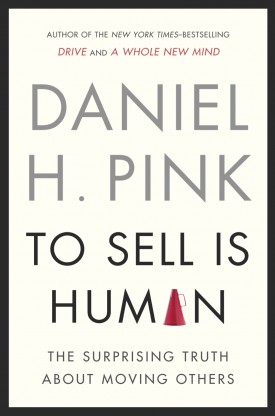- Categories:
A Q&A With Wi8 Opening Plenary Speaker Daniel Pink
 Winter Institute 8 will kick off in a big way, at 8:00 a.m. on Saturday, February 23, with an opening plenary featuring bestselling author and indie favorite Daniel Pink, who will share insights from his latest book, To Sell Is Human: The Surprising Truth About Moving Others (Riverhead). This marks Pink’s third appearance at an ABA Winter Institute, where the extraordinary relevance of his material and his dynamic personality have left booksellers looking forward to his return.
Winter Institute 8 will kick off in a big way, at 8:00 a.m. on Saturday, February 23, with an opening plenary featuring bestselling author and indie favorite Daniel Pink, who will share insights from his latest book, To Sell Is Human: The Surprising Truth About Moving Others (Riverhead). This marks Pink’s third appearance at an ABA Winter Institute, where the extraordinary relevance of his material and his dynamic personality have left booksellers looking forward to his return.
Pink’s provocative books about the changing world of work include the bestsellers A Whole New Mind and Drive (both Riverhead Trade). His books have been translated into 33 languages, and his articles on business and technology have appeared in wide-ranging publications, including the New York Times, Harvard Business Review, Fast Company, Wired, and The Sunday Telegraph. Pink has provided analysis of business trends on CNN, CNBC, ABC, NPR, and other networks in the U.S. and abroad, and he is a well-known lecturer to corporations, associations, and universities around the world on economic transformation and the new workplace.
 In To Sell Is Human, Pink shows us that sales, whether to push a product or promote an idea, isn’t what it used to be as a result of powerful economic changes. However, he recently told BTW, perceptions haven’t caught up to reality. Here, Pink provides a quick preview of some of the insights he’ll share with booksellers at Wi8’s opening plenary.
In To Sell Is Human, Pink shows us that sales, whether to push a product or promote an idea, isn’t what it used to be as a result of powerful economic changes. However, he recently told BTW, perceptions haven’t caught up to reality. Here, Pink provides a quick preview of some of the insights he’ll share with booksellers at Wi8’s opening plenary.
BTW: In To Sell is Human, you point out that statistically, one in nine Americans works in sales—but if you look closer, so do the other eight. How did you reach this conclusion, and what kind of research did the book entail?
Daniel Pink: It began with a hunch. I looked back at two weeks of my own work — the meetings, calls, e-mails, tweets — and discovered, as I’d suspected, that I was spending a huge portion of my time selling. I wasn’t just flacking books, though. I was convincing editors, persuading airline gate agents, cajoling kids — trying to get people to part with resources, to exchange what they had for what I had. However, to put some quantitative meat on these conceptual bones, I worked with a data analytics company to conduct a survey of 7,000 adult full-time workers. We found that people are spending an average of about 40 percent of their time on the job in what I call “non-sales selling” — selling where the cash register doesn’t ring, where money doesn’t change hands, and where the transaction is denominated in time, attention, and effort rather than dollars.
BTW: Why do you think most people don’t realize they are selling in their daily lives? How do you think their behavior would change if they were aware?
DP: Part of it is that we’re so busy getting through the day that we don’t have time to step back and notice about what we’re actually doing. I’ve found that if you mention to people that they’re selling all the time, they tend to pause, think for a moment, and nod their heads in agreement. It doesn’t take a lot of convincing. And once they become more conscious of what they’re doing, they can begin doing it a little better.
BTW: Much of this book seems to be targeted towards “the other eight” — a tool for non-salespeople to develop their selling skills. What do you hope traditional salespeople, such as booksellers, will take away from this book?
DP: Well, I hope they see sales in a new light — as something more about transcendence than transactions, as a way to improve someone else’s life and in turn to improve the world. But most of all, I hope booksellers will learn how to sell a little better — and thereby keep independent bookstores (and writers!) in business. In particular, I think the chapter of Clarity, which discusses how to frame choices and identify problems customers don’t realize they have, will be useful. And the principles I lay out in the chapter on Serve — make it personal and make it purposeful — are right in the sweet spot of booksellers.
BTW: How have traditional sales tactics changed over the years, and how has technology played a part in that?
Most of what we know about traditional sales comes from a world of information asymmetry — that is, the seller always had more information than the buyer. When the seller holds a huge information edge over the buyer — and the buyer has limited choices and no way to talk back — the seller can take the low road. That’s why we have the principle of “buyer beware.” Buyers had to beware because their better-informed counterparts could deploy all manner of underhanded tactics. But in the last decade, the information asymmetry that defined the sales relationship has become something closer to information parity. That’s a world of “seller beware” — and it demands new qualities and new tactics that people are only slowly learning.
BTW: It sometimes seems that being “in sales” has some kind of stigma — why do you think this is, especially since salespeople play such an important role in society?
DP: It goes back to information asymmetry. As part of the survey, I asked 7,000 people this question: “When you think of ‘sales’ or ‘selling,’ what’s the first word that comes to mind?” The answers were a parade of perfidy. Pushy. Sleazy. Slimy. Manipulative. But that view is a relic, a legacy of a time when sellers had lots more information than buyer and therefore could take the low road. Our perceptions haven’t caught up to reality. I’m trying to change that — to give readers a fresh way to think about sales along with all kinds of smart, well-researched advice for navigating this new terrain.
All Winter Institute 8 badged attendees are invited to the Opening Plenary With Daniel Pink: To Sell Is Human from 8:00 a.m. - 9:30 a.m. on Saturday, February 23, in the Westin Kansas City at Crown Center’s Century B & C Ballroom.

